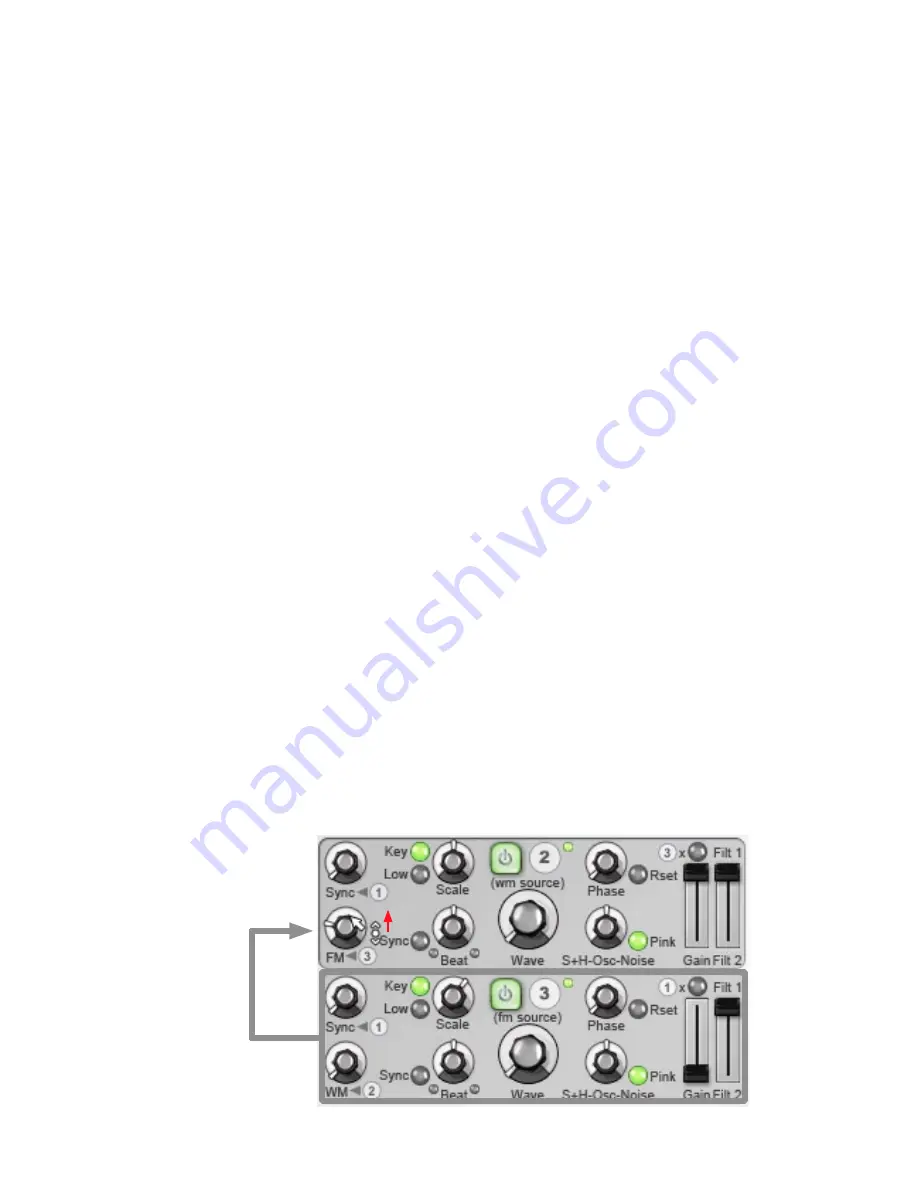
7
4: Cypher’s oscillators in detail
4:1 Introduction to audio-rate modulation
Basics of audio-rate modulation
While subtractive synthesis – using a filter to subtract portions of an oscillator’s frequency range – is relatively easy to
understand, FM and other audio-rate modulation tends to perplex most musicians.
Conventional subtractive synthesis is great for many types of mostly abstract sounds but it isn’t usually sophisticated
enough to produce more complex, ‘realistic’ timbres such as those produced by acoustic instruments. This is because
most real-world timbres involve very complex harmonic variation – harmonics change at very high speeds and in more
complex ways than those made possible by subtractive filtering.
Most modulation in subtractive synthesizers takes the form of control-rate functions such as LFOs and envelopes, which
do not produce fast enough modulation for these complex timbres.
Audio-rate modulation – modulation at frequencies of audible sounds – is capable of producing more complex tones. FM
is one of the most common types of audio-rate modulation, and can be very effective at emulating many types of acoustic
sounds, particularly when using envelopes and other control-rate modulation to dictate the amount of FM applied. For
example, sounds reminiscent of acoustic plucked and hammered instruments are much more convincing when using FM
rather than conventional subtractive synthesis techniques.
Of course, it is not necessary to restrict the uses of audio-rate modulation to producing real-world timbres. It can also be
used for producing new types of abstract sounds that are not possible with conventional subtractive synthesis.
Audio-rate modulation implementations
FM (frequency modulation) is possibly the most well-known type of audio-rate modulation. While it is common to associate
FM with digital synths such as the Yamaha DX and TX series, FM capabilities can actually be found on many analogue
synthesizers. Many classic poly- and monosynths feature FM capabilities, with one osc typically modulating another osc or
the filter. Some examples include the Roland Jupiter series, SCI Prophet 5, Minimoog and ARP Odyssey. Most patchable
modular and semi-modular synthesizers also allow this kind of functionality.
Digital synthesizers have a huge advantage over analogue synths when it comes to FM: it is easy to input exact values
and frequency ratios, and the tuning is stable and reliable. Despite these drawbacks, the sound of analogue FM is rich
and complex. With its meticulously modelled oscillators, Cypher attempts to combine the sound of analogue with the
convenience and stability of a digital polyphonic software instrument.
4:2 Frequency modulation
When you modulate the frequency of one oscillator with that of another, the modulator oscillator is essentially acting as a
very fast vibrato on the modulated osc’s pitch.
An LFO is an oscillator running at low speeds, which produces a vibrato effect when it modulates pitch.
Modulating pitch with an oscillator that runs at audio-rates results in additional harmonics, called ‘sidebands’, being
produced. This leads to a change in tone rather than in pitch.
The nature of these tonal changes depends on the frequency of the modulator oscillator – more accurately, how the
frequency of the modulator oscillator relates to the frequency of the modulated oscillator (known as the ‘carrier’).
Simple, integer-based ratios between the frequencies of the carrier and modulator, such as 2:1, 1:2, 1:3, 1:4, 1:5 and so
on, produce ‘musical-sounding’, or ‘harmonic’ results. The additional harmonics are musically related to the base oscillator
frequency. On the other hand, arbitrary ratios such as 1:2.57, produce more dissonant results.
Cypher allows you to modulate the frequency of Osc2 with the output of Osc3. The overall shape of the Osc3 waveform is
used as the modulator – therefore there are a lot of parameters that contribute to its output. However, the most important
factor is Osc3’s frequency, or pitch.
Osc3 used as FM source
for Osc2.
The
FM from
control
sets the depth of FM.
Содержание DCAM SYNTH SQUAD
Страница 1: ......
Страница 2: ......
Страница 26: ...26 Shaper Filter Amp sections...
Страница 109: ......
Страница 110: ......
















































